Text
PHL-9: Dance Masterpieces
Presented By: Philadelphia Ballet
Philadelphiaballet.org
Ballet has a term called “Ballon” which means that the dancers have the illusion of weightlessness. An ensemble of great dancers who have devoted hundreds and thousands of hours in the studio honing their bodies make it seem like the laws of physics don’t apply to them anymore. In Dance Masterpieces Philadelphia Ballet tries to revive three pieces from choreographers that have put thousands of days into crafting silhouettes and movement on global stages. In essence, they were trying to create the illusion that the laws of time didn’t apply anymore and that the pieces seemed as fresh and innovative as they had decades before when they premiered. Let’s see what happens when a premiere company in Philadelphia dabbles in time travel.
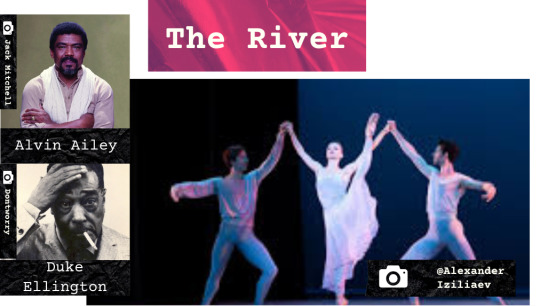
The River: Choreography By Alvin Ailey and Score by Duke Ellington
This piece entertained and astonished us. The flowing of the performer’s bodies matched the flowing rhythms and cadences of Ellington’s music. Anyone who has seen Ailey’s work knows that Ailey composes in supine silhouettes and supple, fluid movements. Ailey loved to showcase the human form, its strength, its beauty, and its power. In this piece you saw the dancer’s muscles and tendons working and muscles working in ways that may seem impossible. The River works height into the composition to create the illusion of depth like we are sinking lower and lower into the water. the performers’ ability to live between the beats proved that artistry isn’t just accomplishing the choreography but breathing a story into it.

In The Middle Somewhat Elevated: Choreography By William Forsythe and Score By Thom Willems
We found ourselves torn by this piece. While it was a great showcase of the performer’s explosive energy and sharp angles it felt hopelessly rooted in the anarchic period that created it. The eighties babies amongst us might remember Willems music as the sound of Gucci and the catwalk. As an iconoclast, Forsythe was trying to pull ballet into the modern world. What we got was a choreography full of sharp lines and angles and stochastic movements, as percussive as the synth music that sounds like a cutlery drawer in the blender (we mean that in the most complimentary way it can be meant). Yet we couldn't take our eyes off of it which is a big credit to the ensemble and maybe Forsythe’s use of composition and aggressive style.

In The Upper Room: Choreography by Twyla Tharp and Phillip Glass
Tharp was one of the names that we were excited about before we even walked in the door. We find Tharp a chaotic voice in the choreographer’s role yet hers was the piece that was making a clear-cut and definitive statement. The duality between street and pointe shoes, athletic wear and pajamas, vernacular movements, and a ballet style that was light on its feet was an essay that landed without saying a single word. The costumes took center stage in Tharp’s message. The style of the clothing forced the performers to move in ways that didn’t seem strictly traditional. As the costumes changed their movements and bodies changed. Because of that, there was a dialogue happening throughout the piece. All of this was set against the background of Glass’s score never settled on a single motif without changing ideas midstream.
0 notes
Text
PHL-8: The Lehman Trilogy
Written By Stefano Massini
Adapted By: Ben Power
Directed By Terrence J Nolen
Presented By:
Arden Theatre Company
tinyurl.com/Get-Lehman-Tix

Dana and I were in college during the Great Recession. Back then you didn’t have to follow the financial news to know that things were dicey. You just had to look at all of the foreclosed houses. You just had to look at all of the jobs that we applied for and found out that no one was hiring. If you have never heard the name Lehman, America’s oldest investment bank and the subject of Massini’s play, in your life you would be forgiven. Massini’s play and The Arden unfold the story of how one of the tent poles of the great experiment called “capitalism” rose from a simple store and slowly ate itself to death.


This play unfolded a docudrama about capitalism that Ken Burns couldn’t direct. It’s a microcosm of how these institutions started and when and how they were able to take over. By first talking about the three brothers humanizes capitalism. In fact, he made it funny (the scoundrel) Also The Lehman Trilogy written by an Italian debuted in London and has an objectivity that we feel could have never been written stateside. It would have been either much harsher on the downfall of a company or it was going to focus too much on the stereotype of the “immigrant story”. This play is VERY American for only having America in the plot.

Dana wants to give this director and his crew a standing ovation. We never felt the time. In every show we have ever seen there was this unspoken agreement that runtimes are just suggestions. Even the most well-meaning shows can drag a tiny bit if they have a three-hour run time. We came in at 1 PM and when the play was over it was 4 PM as promised. Somehow the minute that the lights dimmed and the show started again it felt like time stopped. We were somehow transported one hour into the future when the lights rose at intermission. We credit Nolen with this but there had to be a sweet science between performer, director, and text that sucked us in. Also, Nolen’s ability to juggle so many characters and so many plotlines with only three actors and one set is a huge accomplishment.



Dialect and movement are the only costumes that kept changing. A suit is a suit. Shoes are shoes. But the changing of speech and movement was the crux of what made this play work. Hartley was able to instill vocal confidence into the ensemble so that they could change dialects like changing hats. How dare Cotton be so good! We never thought that the female characters were caricatures put on by men. They felt real, authentic, unique, and individual. Each one had their own movement, shape, and stance. That’s not an easy thing to teach. Cotton’s ability to interpret each character and then create a movement language with the cast is a masterclass in movement arts.
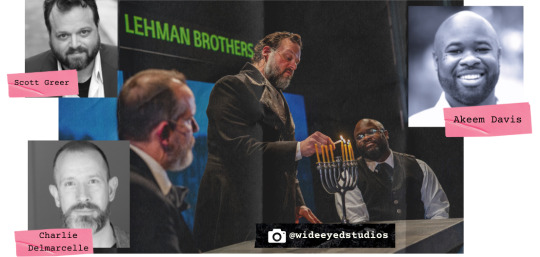
One thing that we have noticed with scripts that come out of Europe is that they place a ton of faith on their performers’ shoulders. In this performance, it is impossible for this ensemble of three to have a bad day. They are carrying all of the characters, all of the plot, all of the story, all of it. Like the tightrope walker in Times Square if they fall just once then the play is doomed. These performers are moving non-stop for an hour at a time, three hours a performance, and sometimes twice a day. That is a marathon feat that cannot easily be accomplished. Add to that all the accent movements, gestures, throwing props around, and never missing a beat. This is the kind of performance that people drive three hours from DC to see.
0 notes
Text
Review 539: I Adore You
Written And Performed By: Parker Sela
tinyurl.com/I-Adore-You-Tix

One of our favorite things about digital theatre is that they are immersive by their very nature. One of our favorite genres in this nesting doll of genres is the immersive audio drama (the performer calls you on the phone). If we would describe the art form for those that have not had their initiation into this small community imagine a drama that feels like it was made just for you. You have an appointment and for the first time, you are waiting by the phone for someone you have never met to spin a yarn for you. Then when they sign off, the moment has passed and the magic is gone. The reason that you keep coming back is for those magic 15-30 minutes. Moments like we had with Parker Sela as we talked about the importance of love letters and how to write them.


The important thing about an immersive experience is that the audience has to feel like there is a special purpose to being on this call but doesn’t feel like they are being pushed, pulled, or dragged through a plot. Sela started differently by first talking about herself. That built a trust and a bond in the first three minutes that paid off amazingly by the end. Exposition in any genre is just trust-building with narratives.

We have to praise Sela for her use of the time. In a phone call show we are looking at a ticking clock that tells us exactly how long our call has been yet we felt we were only on the call for seconds. We also never “felt” the script pages turning. It is very easy in some immersive dramas for the audience to feel like they are “choosing their adventure” or that they are making a weighted choice that has life-or-death effects in the narrative. While we felt that there was a structure to our time together with Sela we could suspend our disbelief and feel like we were just talking to an old friend we had just met.
Ricky likes to use a term that they learned in their old days as a Baptist called “divine appointment” If we reconsecrate that word for the theatre artform it’s that feeling that the audience and the performers had a moment that was just “meant to be”. Sela presented a well-crafted three-act experience with more events and meaning packed in it than a longer staged piece and all wrapped up in a thirty-minute phone call. Yet that’s not the important part. The important part is that it didn’t feel like a show. None of it felt “staged”. It felt like a real moment where both the artist and the audience member shared something real across the ether and had a moment. And what’s more, even if it was complete fiction and a role that Sela sheds like a coat at the end of the call we don’t care. It was thirty minutes that we will be thinking about for a long time.

0 notes
Text
Review 538: Always A Boy
Written by
Jo Ivester & Jeremy Ivester
Directed By: Lisa Scheps
Presented By:
Ground Floor Theatre
tinyurl.com/Always-A-Boy-Tix

The 2024 Young-Howze theatre season seems to include a lot of familial love stories. Always a Boy at Ground Floor Theatre is a script written by Jo and Jeremy Ivester, mother, and son, telling the story about how they were able to bridge the gap between them and embrace the boy that he has always been inside. It’s nice to see trans joy over trans suffering and more supportive parents even if they don’t know exactly what to say. It’s great to see the play that we needed to see as children (or baby trans). What goes on in this play could be classified by us as fantasy, nothing more than a unicorn or the gas under $2.50. However, this story is really real and give so much hope.


One of the things that we want to celebrate is the love that Jo and Jeremy Ivester have for each other. The kind of relationship that they have: the one built on honesty, trust, and admitting fault is not the kind of relationship we (or many trans kids) can claim to have. Many kids don’t have that experience. Many find themselves out on the street. This story would give so many kids and families hope. We would love for the love that these two have for each other to be the lighthouse to guide all further rewrites. This is a love story between a mom and her son. She was willing to drop everything and be there for her son when he most needed it. That is the crux of the play and it’s one we have never seen out of over 500 plays in eight years. That means this is something special.


We feel like Schep's direction was torn between two extremes, these being the sides of the stage. In a story like this, we needed to feel like all the versions of Joshua were breathing down our family’s necks, always there right under their nose yet it seemed like every time young Joshua yelled across the stage or older Joshua entered to talk to the mother we felt like they had to cross a chasm to see each other. If Scheps wanted every inch to feel like a mile then that’s exactly what we got. We just wish that something could have been tweaked in the stage pictures and the blocking so that we felt those choices were intentional.

This strong cast did an amazing job with a difficult script. However, three performers stand out the most to us: Ono did an excellent job playing a baby trans masc without falling into the trap of “tomboy which (based on what we’ve seen) is a very easy trap to fall into. Kelly deserves a medal! They carried the ENTIRE play. They are the characters we spend the most time with and get to know for the most amount of time. They are the character who officially “goes through” the transitioning process. Since all characters in a play are supposed to change and transform the complexity of the trans experience can sometimes drown in that. It takes a complex strong performer to hold a light up to that. If Ono and Kelly were our handholds Fonseca was our heart. We felt her desire to understand, to participate, to be there. That motherly compassion is the blood in the play’s veins.

There is a mission that this play must accomplish way beyond educating, enlightening, or entertaining. This story tells every trans kid, (whether in school right now or trans kids that grew up into adults that have panic attacks when they get calls from blocked numbers) that a loving and affirming family is not a fairy tale. We all know that romance, friendship, and intimacy are possible in theory. Yet can there be such a thing as parents who look their kids in the eyes and see them for who they are? Are there trans children who can sit next to their parents and pose for a photo? Can a mother and son write a play together and talk about how they learned to love each other? This play tells us that it isn’t a pipe dream. Does it need some support and refining? Yes, But does it fulfill its mission even in this raw form? Absolutely!
0 notes
Text
Review 542: The Club
Written By: Chris Bohjalian
Directed By: David Saint
Presented By:
League of Livestream Theatre
tinyurl.com/Get-The-Club-Tix
Ricky came from Tennessee where the taste of racism was so palpable it might as well have been an ice cream flavor. So imagine their surprise when they came to New Jersey and it seemingly “disappeared” it was then that Dana explained the concept of “suit and tie racism”. It’s the kind of racism that lets you into their spaces, gladly proclaims you as one of theirs, yet will talk about you behind your back or say some of the most horrible things about other BIPOC people to your face (but remember you’re not like “those other Black people”) That’s why we found it very interesting to see a play that highlights this kind of racism and the vacuous group of cul de sac dwellers that perpetuate it.

This is the first time we have seen a play that highlights the frailty and shallowness of the white middle class in such a palpable way. We see marriages hanging from a thread, friendships hinging on intoxication, and a husband, Richard, who’s discovered the kind of groveling sycophant he has had to become to maintain his status quo. Yet this script doesn’t zoom in on the drama that makes it most unique. Now the minute our protagonist grows a conscience and saves his “one black friend” from the quagmire it turns out that it’s the worst thing Richard’s ever done. This is the story, the arc, that we feel we should lean into yet we feel that we came into it too late. The damage was already done the minute we started the play and now we are all watching the fallout.
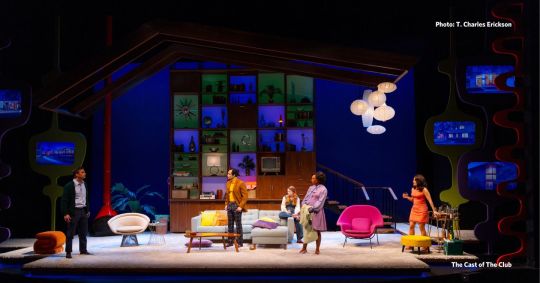

We could smell the tobacco and booze coming through the screen. We also felt a plasticity, a fast fashion and trendiness coming from the decor that echoed the shallowness of the family. The materials of the props and furniture feel insubstantial and flimsy, products of mass production and courtesy of the Montgomery Ward catalog. It all leads to the insubstantial and plastic nature of the main characters that bought them. It’s like a Barbie Dream House come to life. It’s not designed to live in. It was designed to be looked at.

We understand looking back in anger yet this script is almost looking too wistfully into the past. Not like the song “Papa Was A Rolling Stone” by The Temptations instead of vilifying the characters and their negative actions we’re painting them as folk heroes and glorifying them. We see that Bohjalian is trying to show the agony of living in this kind of rat race yet we don’t see the rat race itself. Like we said, the party is over (in more ways than one) and we don’t see any of it committed on the stage. We wish we were in the room when the decisions were made when people were saying their racist and disgusting words, and saw the ugly underneath the surface. Then we could see Richard make the decision. His silence would be overwhelming
0 notes
Text
Review 541: Space Shipped
Presented By:
Phoenix Tears Productions
“Can we have an immersive world where my choices DON’T unalive someone?”
That was the question Ricky asked after counting all the characters in the immersive dramas that we had taken off the census, including ourselves, by choosing the wrong door or outcome. If you’re wondering our body count goes into the forties which includes two actresses, a space explorer, and two bunnies in a space lab. That is why we were excited but reticent when we entered “Space Shipped” by Phoenix Tears. We were just sitting in the waiting room and telling ourselves: “knowing our track record the entire space station is going up in smoke.” That’s when we saw this is nothing of the sort. We are just here for Max’s birthday party and the goal(hopefully) was romance!





Pictured: UL to DR Megan Markham, Lorena Ervin, Logan Creasman, Emilie Sheetz, Mallory Vance
The Ship
...a Romance like our roguish space captain and our person of the hour. Markham and Creasman were two of our favorite performers in the show. They have a very familiar way with each other which made their scenes together really special. We don’t know what decisions it takes to get to their plotline but it’s very worth it.


MAVEN
We were floored by the use of a central AI in the waiting room to anchor the experience together. Maven is ready to spill the tea and share the receipts. This is a great use of both the Zoom platform and the sci-fi genre. Maybe it was Ervin’s special take on the role of a bot that knows everything but won’t divulge anything. We’re wondering when we can discard Alexa and get a MAVEN of our own.

The Duo
Okay, we HAVE to talk about the use of a puzzle element. This group of scallywags will send guests everywhere trying to get passwords or docking codes and it's a very entertaining time just watching them figure it out. Sheetz and Vance draw you in with their affable and roguish manner. it’s hilarious to see them work. You could spend the whole time watching them in The Bottle and not feel like any of it is wasted.

People love to say that we need more queer stories and queer spaces in the arts. Yet what we want to see more than anything is more stories and spaces like this! We want to see more queer sci-fi. We want more queer weirdness. We want to see more spaces online like this in general where the guests can choose how they want to interact, and they can create chaos in a digital realm for two hours. If you haven’t made chaos in an immersive space online and want to know how then keep your eyes glued to Phoenix Tears and catch them the next time they bring their particular brand of Zaniness online.

0 notes
Text
Review 540: John Proctor Is The Villain
Written By: Kimberly Belflower
Directed By: Margot Bordelon
Presented By:
League Of Live Stream Theatre and George Street Playhouse
tinyurl.com/Huntington-Theatre
When we read the title of this play we were immediately stoked. We have had this fan theory about Miller’s The Crucible since we saw back-to-back productions around 2017-2018. It turns out that around this time Kimberly Belflower was commissioned to write a play about this very issue. Looking through the eyes of #MeToo as discovered by Appalachian Teens Huntington Theatre produced this play about a witchhunt and who exactly is considered “the witch”.



Belflower tries to teeter that line between making a stance and letting the characters and the audience form their own opinions. Yet by doing that she essentially takes her foot off the gas pedal of the story. We have simultaneously too much and too little going on in the plot. Hearings, investigations, and accusations are flying outside the classroom while four young women discuss topics that the audience of 2024 has already drawn conclusions about. There are so many characters in the foreground that we see halfway exploring their role in the story yet so many invisible characters (moms, dads, principals, investigators) are moving the plot along. We are so wanting this script to dive further into great character moments like the confrontation between Gallagher and Smith. Show us a final confrontation that’s more visceral than an interpretive dance. By the time we feel like the story is throttling forward towards the real meat of the plot, it’s over and the cast is taking their final bows. That’s why we feel that this script has a great story in it that is lying on the page after “End Of Play”

Bordelon excelled at making these small intimate tableaus with the performers huddled up close together, sitting on the floor, and using the space informally. Then she tries to make these combative scenes where characters are getting heated and then there are no obstacles between these characters being at each other’s throats. All the chairs in this set are upstage and the downstage area is open and bare. Bordelon had this wide and expansive set that hobbled her directing choices. There are no desks to flip or books to throw. This meant that scenes devolved into standing and shouting a lot.
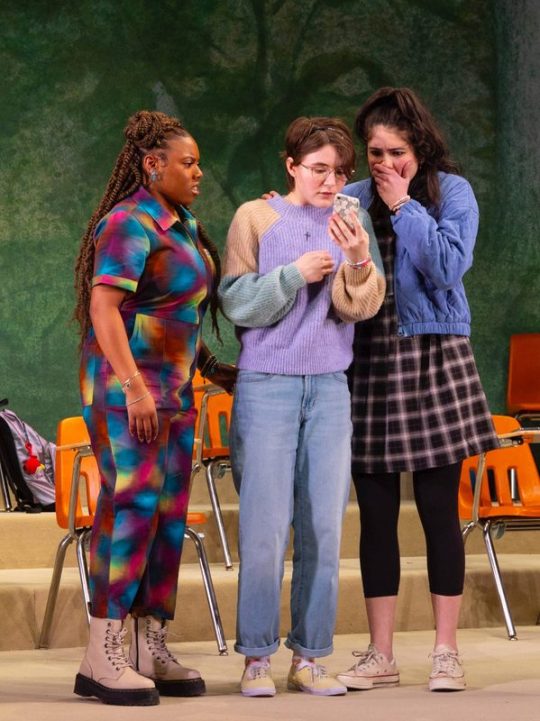

It’s stunning to watch a cast like this throw themselves into the characters, even when they might agree with what their character is saying or doing. This whole ensemble did the heavy lifting to play parts like this. They made characters that we wanted to watch smash the patriarchy with an axe. to play parts like this. They made characters that we wanted to watch smash the patriarchy with an axe. They made characters we‘d love to see doing anything anywhere. It‘s worth giving this play a try just to see each of these performers give their all.
0 notes
Text
PHL-7: The New Electric Ballroom
Written By: Enda Walsh
Directed By: Emma Gibson
Presented By: Hedgerow Theatre
@hedgerowtheatre tinyurl.com/Electric-Ballroom-Tix
As specialists in digital theatre, we have found ourselves looking for those special “you had to be there” moments when we come in person. We became familiar with Hedgerow Theatre when we saw their production of “The Puzzle” in partnership with LOLST. Through the screen, we saw a brilliant theater production (in fact it’s nominated for a 2024 YHTA Award). So when we trekked from our familiar Center City to Rose Valley on the train and walked from the station to the 101 year old historic theater, Google Maps SWORE was straightforward. (Word to the wise: Get a Lyft or Uber from the station) There, we saw something that the screen can’t capture: a theatre created by a community of people who instantly become your friends. A group of artists and patrons that become bigger and more substantial than the brilliant theatre work we’re watching. This is the community we got immersed in well before the house opened and we entered “The New Electric Ballroom”


L: Enda Walsh R: Emma Gibson
Walsh’s writing has us torn between two extremes. On one side we acknowledge the sheer skill it takes to write a play that shows the ritualization of family trauma sheerly through repetition of text and blocking. Like listening to “Minuet in G” or “Rondo a la Turca” we know that passages are going to repeat but he plays with our expectations so much that our anticipation becomes part of the experience. Yet in the other extreme, we find the minimalism of the plot doesn’t support the premise. We felt let down that, after pushing through this rich use of language, repetition, and ritual there was nothing else there. Maybe Walsh wants us to have that anger, that feeling that something substantial has been done but nothing has really happened. Maybe we’re supposed to be angry that the three sister’s lives are lying in ruin for no reason. Maybe but we don’t know.
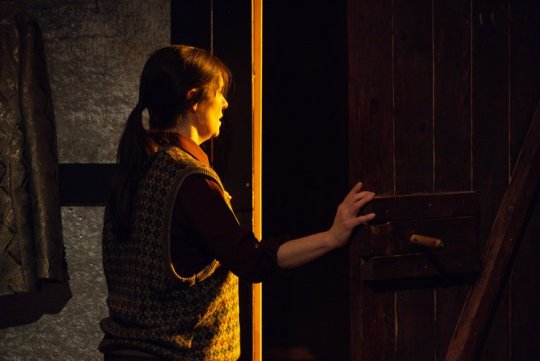
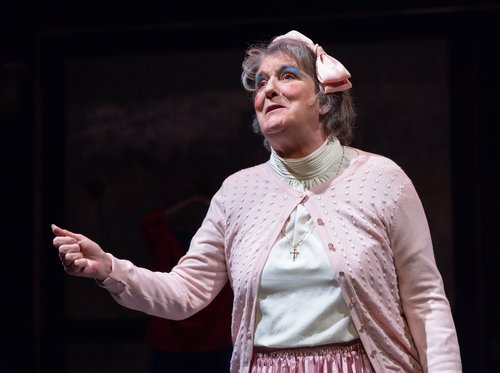

Photo Credit: James Kern Photography
We think Gibson’s touch was giving the cast the energy and the freedom to let loose onstage. To feel and express anger, grief, and crippling longing in a safe space. A lot of this might stem from Gibson’s acting and playwriting background. If a director knows what fuels the engine of a play, what makes the motor of a performer purr like a kitten, then they know when to goose the throttle or tap the brakes. Many times we knew that Gibson was trusting these trained actors to do what they were born to do with words that were finely crafted. Then other times we knew that she was the one giving them the final gentle touch to steer them headlong into the scene with a passion and emotion that had us the edge on our seats.
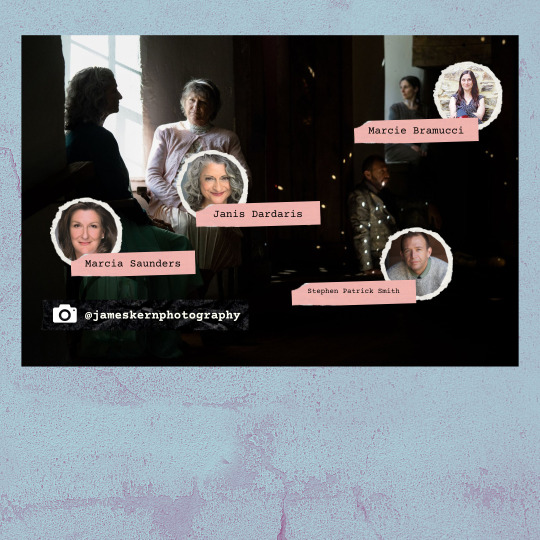
When it comes to these performers we have a problem...they are all spectacular. This is a play where if one performer’s off the whole play falls apart. So the whole ensemble has to work together like a well-oiled machine to get us from lights up to curtain call. This is not years this is decades of performers honing their craft to make a performance like this look as easy as dancing on the promenade. We were captivated by them. They had us watching their every word and movement. They could have played this whole show on a bare stage and we would have missed nothing. That just shows what happens when a show is centered on charismatic and dynamic performers.


L: Georgia Evans R: Elizabeth Hanson
The costume design of this show has made us coin a new phrase, “Look for the hole in the boxers”. It means that when we talk about attention to detail in costume design a simple hole in the boxers changed the game for us. It’s a simple thing that tells us EVERYTHING about a character. And this is why we both want to highlight Evans AND Hanson in their work of bringing all of this design to the stage. With very simple pieces the clothes they changed the story and even characters. That’s the kind of costume design we want to celebrate in this world.

Photo Credit: John Kerns Photography
We’re getting a ride back to the train station from a veteran performer and supporter of Hedgerow Susan Wefel. Wefel graciously offered us a ride when she found out we had walked up and down the blind hills and in traffic to get to the theater. Susan gave us a rundown of the theatre world in the area that only a forty-plus-year veteran could know. On the ride to the station, she gives us inside info about the show that no insert in the program can provide. We have always been skeptical about the prioritization of theatre buildings over the artists inside. Theatre buildings can become idols. We are saying this because we want you to understand this isn’t about a converted grist mill but a community. The space becomes ancillary to a community that loves it and each other. The show becomes part of a landscape in a welcoming atmosphere that makes you feel like you could stay forever. It’s only our first time at Hedgerow but we know we’ll be back. We assure you there is no greater outsider to a theater than a critic and yet they made us feel at home.
0 notes
Text
Before you watch "My Mama and the Full-Scale Invasion" OnDemand at The Wilma Theatre Read our exclusive interview with two of the performers!
@wilmatheatre tinyurl.com/Mama-Invasion-Tix
Opening Thoughts
Lindsay Smiling: “I think what is beautiful about working on this piece is that it is so personal. It’s not just about political bullet points or arguing. What we’re reminded of in Sasha’s writing is marrying what is happening in the world with the very personal story. It’s a parallel of how this affects the world but also how this affects the human beings. You have a very intimate glimpse into the human experience because Sasha is putting her own life very much on display...she was having literal text messages with her mother during the rehearsal process when we were first putting it up in D.C. and having her mother okay the dress that was chosen by the costume designer and wanting to know who the actress was that was playing her. You don’t get to work on very many shows that are in immediate conversation from day to day.”
Suli Holum: “Yury and Sasha both really emphasized throughout the process that ’joy is resistance’...I also like this question of ’what artists can do in the face of moments like this’ and ‘What’s the art for?’ And Yury and Sasha both really lifted up (it’s going to sound overly simple but) the power of the imagination. There’s this thing that Ukrainians have. In their idea of Ukraine and what it means to them and that is the triumph of the imagination. And that really came through when we were working with them.
What Activated The Role For You?
Lindsay Smiling: “I think what it came down to is ‘MAN loves MAMA’ he loves his wife. And that activated something. Where is the love? Where is the love in any of these characters? And that’s what brought me to activate the characters I play ’what does the character love and how do they go for it? And that is also true for at the end of the play, there’s this love that both MAMA and DAUGHTER want to express to each other and share with each other and there is this gulf [between them] and how do you find your way to expressing that and doing that. I think I found that the MAN is in between these two in this gulf and can help bridge that and that became very much the engine for me and it’s hilarious. The way he [bridges that gulf] is to transform into all these different characters to try to make one or the other understand how each other felt.”

Lindsay Smiling
Suli Holum: “Yury and I had a meeting before rehearsals started just to talk about ’what’s the engine of the event and how to [stage] it’. The engine of the play is that Sasha is writing the play and I’m playing Sasha. Nobody wants to watch someone sit down and write. That’s not it! How do you turn that into a catalyst for a presence on stage and an energy? I was so excited by that invitation because I also write and I hate sitting down...so there’s that. Yury’s impulse is always to be drawn to big physicality and the [set] design invites this big physicality a lot of things are actually happening and things can be moving and things are going to be flying through the air. And at one point I was keeping all of the plates spinning and Sasha just said, ‘You’re a writer, you’re a serious person’...Between what Yury needed...and Sasha being right there to say ‘hello, you’re a physical representation of me’. I really had some hard and fast things laid down for me.
Thoughts On The Process
Lindsay Smiling: “There were several pages that came very late in the process. There are several world leaders that show up in the play and Sasha would have to ask ‘What does Joe Biden sound like? What is the big deal with the aid package and there was stuff with events around American politics and what was our experience with them that she asked us for...We had to figure out ’what is our vocabulary? We could put on a foreign accent but we’re not going to do that.’ So there was that aspect of it. And then there were some things geographically happening that we [the American performers] had to understand that were happening that weren’t very clear. Everyone in Ukraine would know but no one here would know the relationship between the city or what even going to a beach when you’re a sick child [means]....when you’re sick you go send your kid to a beach resort. Not for vacation but to get better and it’s like the infirmary. We had to understand what was the culture.

Suli Holum
Suli Holum: “There’s a line in the play ‘oh my poor Soviet Childhood’ and it’s the laugh line for both Sasha and Yury because they share those experiences of childhood that are very specific and we had to be let in on all those jokes. Our associate artistic director Kellie Mecleary was responsible for the American adaptation. She was so great and she was there every step of the way because it’s like going through [the script] with a fine tooth comb she can make these big sweeping translation choices but then she gets into the nitty gritty of like ‘Wait how do you say that?’ Because if you have a word that is in the wrong place in the sentence and it changes the whole meaning. It was great to have Kellie and Sasha there because...it’s so rare to get to do that fine work of translation.
The Way You Talk About The Process Almost Feels Like Devising
Suli Holum: “Another thing that is really exciting about Sasha as a playwright is that her writing is aesthetically pretty spare. And there is no indication in the script of what should be happening onstage or what the set looks like. No description of that at all...and it actually lends the script some urgency or maybe the impression of some urgency in the process because she’s calling it Theatre of Immediate Response because she’s going through this right now this is happening right now and she’s throwing things down on the page that reflect what’s happening. She’s not musing about stage picture is or the lights she’s just getting it out there. And so, like in a devising process where the rehearsal room is a laboratory, there was healthy trial and error on our part [deciding] what’s the right tone and how to scaffold the text so that there is clarity but so it is lifted and supported in a way that’s theatrically engaging.
Lindsay Smiling: “Suli and I are part of the [Hothouse Acting Company] at The Wilma Theatre. It is very much like a devising company in a lot of ways. I wouldn’t classify most of our work as devised theatre but the way we approach the rehearsal process is often [like that]. Even when we’re not in rehearsal for a production we are meeting every Monday and training and working on stuff that has nothing to do with a production. We’re working on how to move together and how to breathe together and how to create with each other and listen to each other...and that’s a regular process that we are in...I think it lends itself to do some really exciting trials and errors. And I would say that’s one of the biggest strengths of The Wilma acting company is that we can make some pretty huge shifts if something isn’t working and still feel comfortable with each other and complement each other with what we come up with."
“This is a play about Ukraine and there is humor but in tandem with that, this is a mother and daughter story. This is about the love between a mother and a daughter...a love story THROUGH a mother actually... and how powerful that is despite everything that’s happening in the world.
~Lindsay Smiling
1 note
·
View note
Text
Review 537: Dragon Lady
Written By: Sara Porkalob
Directed By: Andrew Russell
Simulcast By: League Of Livestream Theater
@thepublicpgh tinyurl.com/LOLST-Dragon-Lady
Ricky grew up in a housing project on the opposite side of the country from San Francisco where Porkalob grew up yet when the solo performer starts her “karaoke-position” (exposition via karaoke) it started feeling eerily familiar. Porkalob quotes in a preshow interview “This is what happens when you know who you’re making art for” (RnD paraphrase), Porkalob then went on to recount their very personal and very touching story about her grandmother and the rest of her family. Some things are as universal as the moon and stars in the sky. We see stories like these but it takes a unique person like Poraklob to take her personal story and make them shine.


L: Sara Porkalob R: Andrew K Russell
Solo performers have a very special place in our hearts because their performances can be run with clockwork precision. Porkalob can change characters with a single movement of a hand, the turn of a head, and a shift in their stance. Not only that but she is portraying a whole group of siblings at two different ages and we can still tell exactly which character is speaking and what time period we are in. To shift characters, times, and locations without missing a beat takes a high level of skill. To do all of that without a single change in costume and prop takes a very high level of mastery.
Russell was able to seamlessly dovetail his passion and skill in storytelling with Porkalob’s rich narrative. In solo work and storytelling, there are a lot of ways that directors can provide support. You might say that it takes a village to bring certain solo shows to life. Yet, ideally, the director’s work fades so invisibly into the background so that the audience doesn't know where the solo artist’s work stops and the director’s work begins. That’s how we have a sense that the staging, the reveal of the Grandmother’s picture at the end, and many of the design choices have Russell’s fingerprints on them yet we’ll never know unless Russell and Porkalob let us know. The work of a solo performance or storytelling director is not one of ego and recognition but nurturing and infrastructure.



L: Pete Irving C: Mickey Stylin R: Jimmy Austin
One of the more visible signs of support in the show was the shadowy Jazzmen behind the curtain. Three of the group “Hot Damn Scandal” these three musicians held it down and became a soft sonic bed for the story to lie in. We cannot imagine what this show would look like or sound like without this key element. You can tell Porkalob and Irving worked hand in hand to find a rich vibrant sound that was both modern and classic and knit the whole story together. This is a solo show that has the pure DNA of a musical.


Photo Credit: Michael Henninger
Anyone who has listened to the great singers of the time knows what we mean when we say that sometimes the singer surpasses the song. We’ve heard “Ballin’ the Jack”, “Misty” or “Cherry Pink and Apple Blossom White” a million times but there are those special voices out there that make them all feel so fresh and new. Family tales of trauma, poverty, and abuse are so universal that (sadly) they could be considered American standards. Yet a performer like Porkalob can come in and make these universal experiences flow through us like new water from a fresh stream. We will always be in awe of artists with that ability.
0 notes
Text
Review 536: Ballet Hispanico at The 92nd Street Y, NY
By: Ballet Hispanico
Presented By:
The 92nd Street Y, New York
@ballethispanico tinyurl.com/Ballet-Hispanico-Tix
One of the things we love about dance companies is that they have a repertoire. That means that they have a wealth of pieces that they can pull from across the whole history of their company. A dance company literally honors its history and can bring it out for the audience at any time. This night Ballet Hispanico, the largest Latine cultural organization in the US, brought out three pieces from their repertoire that honored three choreographers and their attempts to show us what community and togetherness meant to them. The results were stunning to say the least.
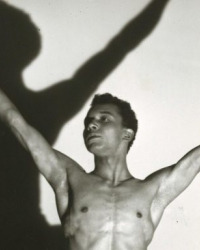


L: Talley Beatty C: Annabelle Lopez Ochoa R: Pedro Ruiz
Recuerdo de Campo Amor (1985)
This piece exudes fluidity and strength but also possesses power and tenderness. It is a study in extremes. While we can see every muscle and sinew working on the dancers as they move with power we also notice a peaceful grace. There is a synergy between a choreographer and a performer. Not only do performers have to honor the choreo precisely but also their artistry is interpreting the movements and living through each sequence as if it was what they were destined to do. This ensemble kept the movements so fresh that we were teleported back to 1985.
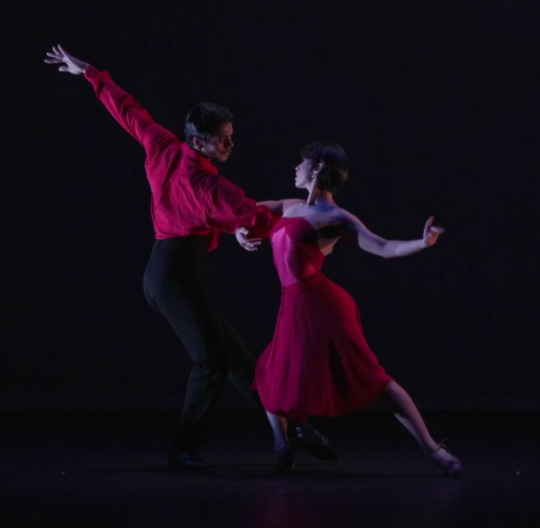
Línea Recta (2016)
It is a refreshing thing to see a piece centering the feminine body and form and not feel objectifying at all. The principal dancer in this role was just as enrobed in a spirit of agency, passion, and power as she was in gorgeous flowing red cloth. We adored that the costume seemed like her most loved dance partner. It wrapped around her and soared through the air behind her. We love it when costumes and props can transcend and be something more than what they are. Then Lopez Ochoa’s play with symmetry and dissonance in ensemble work brought an already amazing piece to a spectacular finish.

Club Havana (2000)
There is a story going on in this piece that rivals anything the writers of the Great White Way could put up. This is the piece that had the absolute perfect balance of partner work, solos, and ensembles. It so invoked the Club Havana of its namesake that we could almost smell the food and felt like we needed a drink. Choreographers like all artists want you to feel something, anything with their work. Cuban native Ruiz would be happy to know that it made us feel like flying to Cuba just to see if it looked anything slightly like this.


0 notes
Text
Review 535: The Tempest
Adapted and Directed By:
Joseph Discher
Soundscape By: Leigh Roberts
Presented By: Knock At The Gate
@knockatthegate tinyurl.com/Gate-Tempest-Tix
One of the greatest joys that we get to have as critics is watching (or in this case listening to) highly talented artists do what they’re best at. In the case of Knock At The Gate’s audio production of Shakespeare’s “The Tempest” We get to see a crew of three sound mixers and designers use Binaural sound and Partner with director Joe Discher and a cast of very talented performers to take the audience on a journey to a faraway island where schemes meet sorcery. Yet we feel like some of the sonic sorcery in this piece far overshadows any tricks Prospero has up their sleeve.

Joe Discher
We have seen, and heard, a whole lot of Shakespeare adaptations. Usually, an adaptation of the Bard’s work is trying to “fix” a problem with the text (update some of the dated language or cut it for time). Yet Discher had to partner with the bard’s poetic language to create a cornucopia-like cacophony for our ears. He had to use the natural resources already available in Shakespeare’s text (verse, music, heavy descriptions) and then turn them into a performance to delight our ears. Where most Shakespeare adaptations try to engage all the senses Discher used our ears as a gateway to perform on the stages of our minds.

When creating an audio drama the soundscape designers and the editors become set designers for the world projected on the back of our eyelids. That’s where the Soundscapes by Roberts comes in to give the world depth and geography. Then you have the audio effects that act like costume designs for the voice. This is how we can tell that Ariel is magic and Caliban is a half-fish half-human hybrid. These effects are what help us know the audio world of our story and the people inside of it.
0 notes
Text
Review 534: Nosferatu
Created by: Joshua William Gelb, Nick Lehane, and Normandy Sherwood
Presented By: Theater in Quarantine
and NYU Skirball
@joshuawilliamgelb nyuskirball.org/events/nosferatu3d/
When Ricky was first learning stagecraft a professor pointed at two platforms that had just been bolted together and said “Oneill, Glasspell, most of the great work coming out of the Provincetown Players started in an 8-foot by 8-foot stage just that size in an abandoned wharf”. That started Ricky into a lifelong love of Black box spaces and how they revolutionized how new plays were made. So when Joshua William Gelb announced at the beginning of this live stream that every scene was staged in a space about the size of a closet we were immediately intrigued. Add to that the technological acumen it takes to make that experience 3D and using mainly effects that work in-camera and projections then you have a beautiful remake of a silent horror classic, Nosferatu



L: Normandy Sherwood C: Joshua William Gelb R: Nick Lehane
It was very interesting how the creative team used some age-old techniques that were invented in the silent film era. They’re classic techniques because they work. Watching this you will notice that the performers never stop moving. In a thirty-minute piece, we don’t think anyone ever takes a break. It takes a lot to tell a story without words in the best of times but then take the physicality of horror, mixed with physical theatre and the speed required to make sure there's not a dull moment in this small performing space and you get a three performer tour de force.
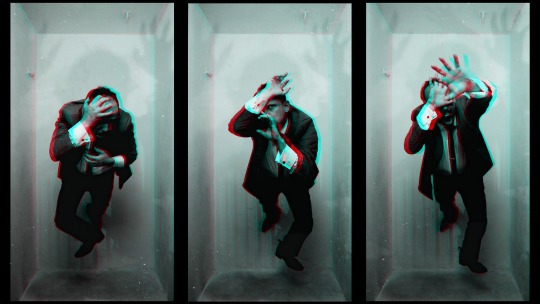
We are so glad that this kind of experiment and performance space exists. In a world where everyone is holding a device that they get all of their news, socialization, and entertainment maybe this is an opportunity for refreshing older stories and telling them in some new ways. we always say that digital theatre is where theatre and film shake hands. We would love to see this setup being used in more places. We hope they become as ubiquitous as black box theaters. We can’t wait to see what new stories will be told when writers, directors, and performers come together and take advantage of this new platform.
0 notes
Text
Review 533: Yoko
Written By:
Kosuke Muroi and Namiko So
Directed By:
Kazuyoshi Kumakiri
Presented By: Japan Society
@jsfilmnyc @rinkokikuchi tinyurl.com/JS-Family-Flux-Tix
The term “emotional rollercoaster” is a highly overused phrase. However, in the case of this film rollercoaster is the only proper way to describe it. In the course of two hours, we went from laughter to terror, to tears, and back again. What you’re going to see in this film is a story so organic, natural, and real that it feels very authentic and sincere. This is the story of a woman who went to bury her father but along the way unearthed herself.
The camera was able to create a sense of loneliness even in scenes where Yoko was with people. By using wide shots and extreme close-ups we were in Yoko’s world and it was lonely. Kumakiri’s shots were such painted pictures that any shot in the film would remind you of where you were in the story. By using the backdrop of Japan and regular locations, nothing fancy or overdone, he was able to tell a whole story.

Kazuyoshi Kumakiri
The best decision in this screenplay was the inclusion of the silent Dad apparition that followed Yoko everywhere. It seemed like he was a hitchhiker in her brain. We caught a glimpse of what their relationship must have been like. It makes the audience beg the question, “Why is she going to his funeral in the first place?” In essence, we learn that she has to. Not just for a family obligation. She needs to finally face him after twenty years and bring closure to her life. By burying her Dad she’s also burying the past and moving on. It just so happens that on the way she also finds her voice as she hitchhikes the hundreds of kilometers to see him to the afterlife.

Rinko Kikuchi
If you don’t understand film acting at all you might miss the sheer amount of skill and talent that Kikuchi brought to this role. She is the central focus of the audience’s full attention for nearly two hours. She has to take up the space of a confident person while still appearing like she’s trying to make herself small. If any part of her performance slips. If her acting wasn’t on point we the audience would lose our only handhold into the film. There is no one else to relate to. For that alone she gained two fans for life.


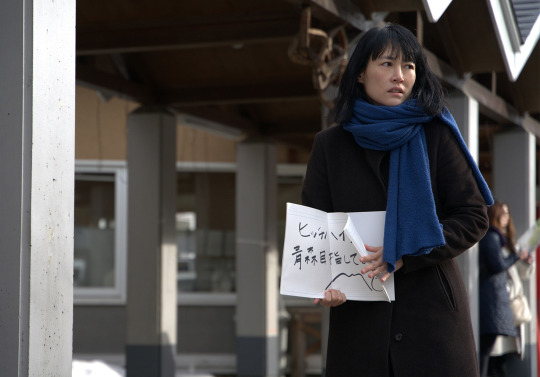
This movie is almost literally the Hero’s Journey. You could put Yoko’s journey up against Odysseus, Perseus, Jason, or anybody else in Greek mythos and it would line up almost beat for beat. One of the two of us (it’s Dana) sat through six years of film classes and thought that this was the perfect film for teaching proper story structure. Yoko travels and learns and grows as a person and becomes different from the person we started the movie with. No matter what we think about the decision to go to her father’s funeral the journey wasn’t about him it was about her.
0 notes
Text
Review 532: Tsugaru Lacquer Girl
Written By:
Kensaku Kojima, Miyuki Takamori, Keiko Tsuruoka
Directed By:
Keiko Tsuruoka
Presented By: Japan Society
@jsfilmnyc tinyurl.com/JS-Family-Flux-Tix
Ricky’s grandfather used to pour concrete. There wasn’t a driveway in their small town or a sidewalk at their university that didn’t have his fingerprints on it. He had intense pride in his work and he never left a job without making sure that it was perfect. It was that same look of serenity when he was doing a job that Ricky and Dana saw in the main characters of this film. The serenity of a job that brings you joy and connects you to a community.

Keiko Tsuruoka
This is a film that had a deep respect for the craft that it was showing, Tsugaru lacquer work. You could tell that Tsuruoka had taken the time to get to know every step in the process. She also wasn’t afraid to let the imagery take center stage. There are several sequences where we are watching the characters work without dialogue. Yet we can still feel the story through how they use a brush, how they watch each other work, or how tired they look when they finish a piece. The camera doesn’t skimp on these details just as they wouldn’t skimp on their craft.
We love that this is a love story between an artisan and her craft. The piano is a perfect expression of this love story. This is the instrument that her mother never let her learn to play and the art form that her father never thought that she would be able to master. The piano becomes an intersection of passion and her history. It’s her statement to the world that she will live her life by her own rules.

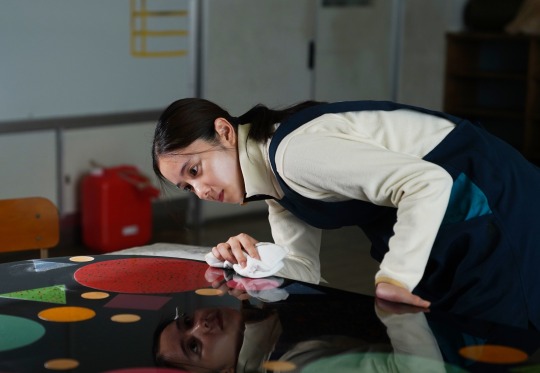

This is a film that relies heavily on location. The cramped environment of the workshop with her Dad Seishiro or the widespread yet desolate nature of the neighborhood. Each place feels closed off and Miyako feels like a visitor in her hometown. Sadly very many of us could say the same. We latch onto Miyako’s story because we all hope to one day find something that will fulfill us as much as her art did for her. All of us crave acceptance, expression, and a sense of belonging. Miyako’s story reminds us that sometimes we have to listen to that inner voice that tells us to keep trying even when the world doesn’t understand.
0 notes
Text
Review 531: Hoyaman
Written/Directed By:
Teruaki Shoji
Presented By: Japan Society
@jsfilmnyc tinyurl.com/JS-Family-Flux-Tix
Who knew that the simple Hoya could become a symbol of losing the courage and intelligence to move on with your life? In the very beginning, we learn that Hoyas move until they stay put, lose their brains, lose their spines, and then go nowhere until they are plucked by fishermen to be eaten. If that isn’t a metaphor for something we don’t know what is.
This was a beautifully shot, simply plotted film. One of the things that we love about this film is that the plot is very easy to understand even with all the layers to the story. That means that you get to dive into the plot and just have fun. Shoji used tension and longing very well. Our characters were battling hunger, grief, poverty, and a whole range of needs. The entire film rotated around how our characters battled needs like hunger despite PTSD. At first view, you think they are fighting against the island but when you look more closely you start to realize it’s a battle for self-identity. Then when they finally figure out what they want. there’s a screaming animated jazz explosion (seriously it was one of the best shots in the film).

Teruaki Shoji
The filming of tension in this movie is really superb. The camera becomes a vessel for their emotions focusing in on their faces and telling us that what the character wants to say is not coming out of their mouths. Or it shows us that a fight isn’t about violence but a battle of wills. Using the camera the director shows the chasm in between people quite literally. That means that when the characters finally do touch it has the most cathartic impact. In film when a character chooses to have their characters that far apart onscreen it’s for a reason. People are much easier to film when they are standing close together.
We haven’t seen a film in a long while that has used a small cast like this in such an impactful way. Each one of them had the talent and charisma to carry a whole film on their own yet combined they meant something much more. With these five characters, you had everything you needed. You have an outsider coming to the island for the first time as a means of escape, a duo of brothers who don’t know anything besides the island, and two elders who have to be makeshift parents to anyone who needs it.
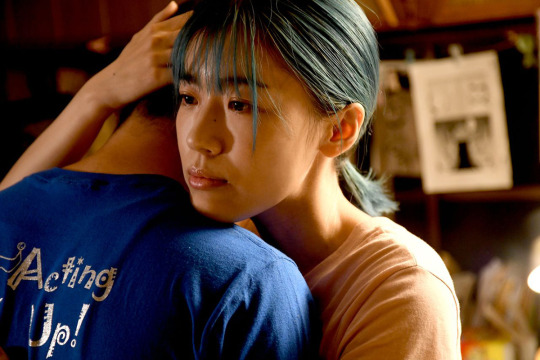


This is a movie about family and community. It is also a movie about trauma and healing. The film brings us to the island and makes us fall in love with it even as we are told that we are trapped by it. That’s because it also clues us into the twelve-year journey of overcoming the tragedy of the sea swallowing up your family and livelihood. Yet it’s also not about moving past tragedy it’s about moving past ourselves. Each of our characters learns how to embrace their flaws and in turn, embrace each other for everything that they are. Whether it’s a writer learning to own up to their mistakes or a brother learning how to carry his weight each had to take a hard look at themselves and discover their own truth.
0 notes
Text
Review 530: The Scarlet Letter
Written By: Kate Hammill
Based On The Novel By:
Nathaniel Hawthorne
Directed By: Shelley Butler
Presented By: League of Livestream Theatre
@leagueoflivestreamtheater @tworivertheater
tinyurl.com/Red-A-Tix
When we were baby critics before the pandemic we were getting into the car after a high school production of The Crucible when Dana turned to Ricky and said “You know we’re supposed to hate Abigail Williams but I’m on her side. She was taken advantage of by her employer (we would call it assault in today’s terms) and if she had gotten caught she would have been flogged or worse. The only recourse she had in this society was to burn it all down to the ground.” Now in 2024 we’re watching another play where we feel the only ending that would make us feel warm and cozy on the inside is lots of village destruction. Kate Hamill brings us the tale of a woman who had very little choice but to live with her secrets in a world that hated her. Two River Theater brings that to life in the world premiere.




UL: Shelley Butler UR: Kate Hamill DL: Amelia Pedlow DR: Nikki Calonge
Despite our understanding that this is an adaptation of the book, we couldn’t tell what modern themes Hamill was imparting on the play. In the curtain speech, we are told that this play is supposed to be not just about us then but about us now. Yet we feel like the play is stuck at a crossroads but hasn’t chosen a direction. In the distance, we could see lights of themes like reproductive justice, women’s rights, and even neurodivergence on the horizon. They’re wonderful topics with a lot that needs to be said about them but we feel the play didn’t take a step in any clear modern direction. This play has a ton of potential and we would love to see it being done all over instead of other more tired plays in the canon on the same subject. We would just urge Hamill to examine the stand that she wants to take with this play and make sure that it comes through loud and clear.
A lot of Butler’s work is seen in the heavy monologues in this play. Butler has a great way of crafting stage pictures that emphasize tension. Sometimes it was so thick that a knife couldn't cut it. We were, however, missing the same attention paid to action and movement. Sometimes it felt like the actors were just moving from one great tableau to another. Then there are the great interactions between Hester and Pearl. We would love to see the same intention and meaningful movement that was used in these scenes throughout the whole play.



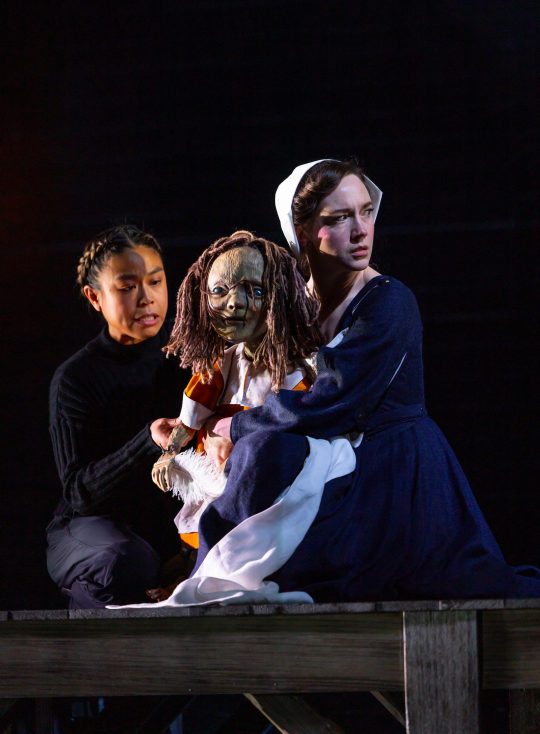
We were going to say a whole lot of things about the use of puppetry for Pearl. We have several questions. But none of those questions matter when you have a great puppeteer that makes you forget at times that there is even a puppet at all. Pearl was a complete character and even our personal favorite. In a world of Puritans, we would always choose to be Pearl. So we would love to spend this time commending the artistry of Colonge and the teamwork she displayed with Pedlow at times to create a character that transcended the yarn, fabric, and wood it was made of and became a whole character.
Hester and Pearl’s relationship is the crux of this play. It is the part of the story that is the easiest to latch onto. And it’s the strongest thread from beginning to end. A theatre pal once told us that every good play is a love story. Wikipedia would have you believe that this is a love story between Hester and Reverend Dimsdale. Yet in all honesty, this is the love of a mother and child and the strength it gives them to get through anything. There’s a lot in this play to teach a new generation that labels don’t define us. We would love to keep track of this play’s development and see what Hamill brings to the stage next. This kind of love story is one that needs telling.
0 notes